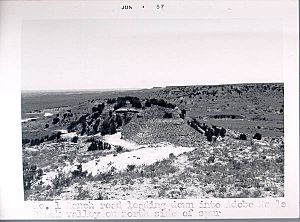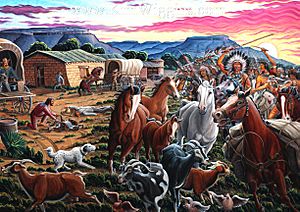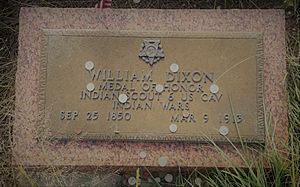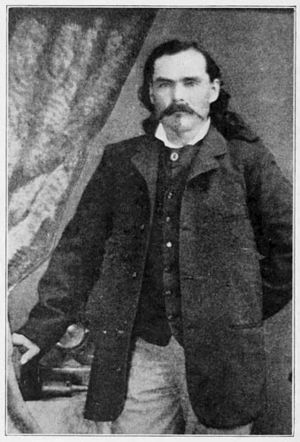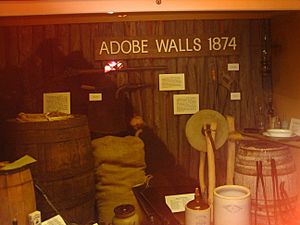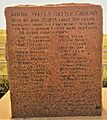Second Battle of Adobe Walls facts for kids
Quick facts for kids Second Battle of Adobe Walls |
|||||||
|---|---|---|---|---|---|---|---|
| Part of the Red River War | |||||||
 Adobe Walls battlefield looking southeast from Billy Dixon's grave. |
|||||||
|
|||||||
| Belligerents | |||||||
| Comanche | |||||||
| Commanders and leaders | |||||||
| N/A | Isa-tai (Kwahdi Comanche) Quanah Parker (Nokoni Comanche) Kobay-oburra (Kwahadi Comanche) Pearua-akupakup (Nokoni Comanche) Mow-way (Kotsoteka Comanche) Tabananika (Yamparika Comanche) Isa-rosa (Yamparika Comanche) Hitetetsi aka Tuwikaa-tiesuat (Yamparika Comanche) Guipago (Kiowa) Satanta (Kiowa) Tsen-tainte (Kiowa) Zepko-ete (Kiowa) Little Robe (Cheyenne) White Shield (Cheyenne) |
||||||
| Strength | |||||||
| 28 hunters and tradesmen | ~700 warriors | ||||||
| Casualties and losses | |||||||
| 4 killed, unknown wounded | estimated 30 killed, unknown wounded. 15 bodies lay too close to the walls to be recovered + 1 killed long range | ||||||
The Second Battle of Adobe Walls was a fight on June 27, 1874. It happened between Comanche warriors and a group of 28 Texan bison hunters. The hunters were defending a small settlement called Adobe Walls. This place is now in Hutchinson County, Texas. Adobe Walls was a very small outpost in the huge Great Plains. It was a lonely spot, not well known to many people.
Contents
About Adobe Walls
A Trading Post in Texas
Adobe Walls was the name of a trading post in the Texas Panhandle. It was located just north of the Canadian River. In 1845, a fort made of adobe (a type of mud brick) was built there. This fort was meant to protect the trading post. However, traders blew it up three years later. This was because Native American groups attacked it many times.
First Battle of Adobe Walls
In 1864, the ruins of this fort became a battle site. This was one of the biggest battles ever on the Great Plains. Colonel Christopher "Kit" Carson led 335 soldiers from New Mexico. He also had 72 Ute and Jicarilla Apache Scouts with him. They fought against more than 1,000 warriors from the Comanche, Kiowa, and Plains Apache tribes.
The Native American warriors forced Carson to retreat. But Carson was still seen as a hero. He had successfully fought the Native Americans. He also led his men out of a dangerous trap with very few losses. This battle is known as the First Battle of Adobe Walls.
New Settlement at Adobe Walls
After 1872 and 1873, many buffalo were hunted in the northern areas. So, hunters moved south and west. They went into good buffalo hunting lands near the Canadian River. This area was known as "hostile Indian country."
In June 1874, ten years after the first battle, some business people set up two stores. They built them near the old trading post ruins. They hoped to bring the town of Adobe Walls back to life. The new settlement quickly grew. It included a store and a corral (Leonard & Meyers). There was also a sod saloon owned by James Hanrahan. A blacksmith shop (Tom O'Keefe) and another sod store (Rath & Wright) were also built. This store bought buffalo hides.
These businesses served about 200-300 buffalo hunters in the area. By late June, Native American groups had killed two hunters. This happened 25 miles downriver on Chicken Creek. Two more hunters were killed in a camp north of what is now Clarendon. News of these attacks spread to all the hunting camps. Many hunters gathered at Adobe Walls for safety.
Native American Alliance
The remaining free-roaming Southern Plains groups saw the trading post and buffalo hunting as a big threat. These groups included the Comanche, Cheyenne, Kiowa, and Arapaho. The 1867 Medicine Lodge Treaty had set aside the land between the Arkansas River and Canadian River. This land was for Native American hunting. But since 1873, buffalo hunters had been in this area. This was against the treaty and made the Native Americans very angry.
In the spring of 1874, the Native American groups held a Sun Dance. A Comanche medicine man named Isatai'i promised them victory. He also said that bullets would not harm warriors who fought the enemy.
The Battle Begins
On June 25, 1874, James Hanrahan and his group of hunters left Dodge City, Kansas. They were heading for Adobe Walls. On June 26, they met a group of Cheyenne warriors. This was at Sharp's Creek, about 75 miles southwest of Dodge City. The Cheyenne took all their cattle. The hunters then joined a wagon train going to Adobe Walls. They arrived just hours before the main battle.
About 28 people were at Adobe Walls. This included James Hanrahan (the saloon owner). It also included 20-year-old Bat Masterson and William "Billy" Dixon. There was also one woman, the wife of the cook, William Olds.
The Surprise Attack
At 2:00 AM on June 27, a loud cracking sound came from the saloon. It was the ridgepole holding up the sod roof. Two men thought it sounded like a rifle shot. Some stories say Hanrahan woke everyone by firing a gun. He then told them the sound was from the ridgepole. It's believed he knew about the attack beforehand. He didn't tell anyone because he feared men would leave, hurting his business.
Everyone in the saloon and some others immediately started to fix the roof. So, most people were awake at dawn. A large force of Comanche, Cheyenne, and Kiowa warriors then swept across the plains. They planned to destroy the Adobe Walls settlement.
The Native American force was very large, with over 700 warriors. They were led by Isatai'i and Comanche chief Quanah Parker. Quanah Parker was the son of a white woman named Cynthia Ann Parker who had been captured. Their first attack was very strong. The warriors got close enough to hit the doors and windows with their rifle butts. The fighting was so close that the hunters' long-range rifles were not useful. They had to use pistols and Henry and Winchester lever-action rifles.
After the first attack was pushed back, the hunters used their large-caliber, long-range Sharps rifles. These rifles helped them keep the Native Americans away. Nine men were in Hanrahan's saloon, including Bat Masterson and Billy Dixon. Eleven men were in Meyer's & Leonard's Store. Seven men were in Rath & Wright's Store.
The hunters lost four men, with three killed on the first day.
Holding the Fort
By noon, the Native Americans stopped charging. They took positions in different places. From there, they kept firing steadily at the buildings. By 2 PM, they rode out of range to the foot of the hills. By 4 PM, the people inside started to leave the buildings. They gathered items and buried the dead. The Native Americans stayed in the distance. They were deciding what to do next. They were effectively surrounding Adobe Walls.
On the second day, the people inside buried or moved the dead horses. More hunters arrived at Adobe Walls. Henry Lease volunteered to ride to Dodge City for help. Two other hunters visited nearby camps to warn them about the attacks.
Billy Dixon's Famous Shot
On the third day after the first attack, 15 Native American warriors rode onto a bluff. This bluff was almost a mile away. They were looking at the situation. One of the hunters asked Billy Dixon to shoot. Dixon was known as an excellent shot. He used a rifle he borrowed from Hanrahan. He aimed and shot a warrior off his horse. Dixon later said it was a "scratch shot," meaning it was lucky.
Seeing their fellow warrior killed from such a long distance seemed to discourage the Native Americans. They left the area and gave up the fight.
More hunters arrived in the following days. By the sixth day, there were about 100 men defending Adobe Walls. The Native Americans stayed nearby for some days after the first attack. Quanah Parker was wounded, which might have made the attack less strong. This often happened with the Comanches when their war chief was hurt. The Native Americans soon left. They likely realized they couldn't force the hunters out of the buildings. Reports on how many people were hurt vary. But most agree that fewer than 30 people died in total.
Within a week of the fight, 25 men went to Dodge City. This group included Hanrahan, Masterson, and Dixon. When they arrived, they learned that a group of 40 men had already gone south. This group, led by Tom Nixon, was sent to bring back Mrs. Olds and most of the men.
By August, a group of soldiers arrived at Adobe Walls. Lieutenant Frank D. Baldwin led them. Masterson and Dixon were scouts for the soldiers. A dozen men were still at Adobe Walls. The next day, the soldiers and the remaining men left Adobe Walls. They headed south to join General Nelson A. Miles' main army. The Native Americans later burned the village to the ground.
The Long Shot Controversy
There is some debate about how far Billy Dixon's shot was. Some say it was about 1,000 yards. But a survey by U.S. Army surveyors measured the distance at 1,538 yards. For the rest of his life, Billy Dixon always said the shot was just lucky. His memories don't even spend a full paragraph on "the shot." However, he did tell people that he took the shot from a rock outcrop. Hunters often used this spot for a shooting game.
Experts have found that the guns used at Adobe Walls included several Colt Paterson pistols. There were also some Smith & Wesson Model 3 pistols and at least one Colt Single Action Army pistol. Many rifles were also used. These included rifles that fired .50-70, .50-90, .44-77, .44 Henry Flat, and at least one .45-70 caliber bullets.
After the Battle
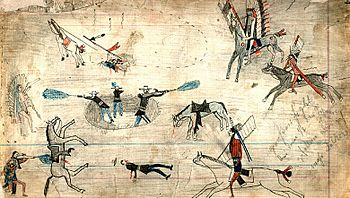
Buffalo hunting in that area ended, just as the Native Americans had hoped. The result of Adobe Walls was a big setback for the Native American groups. Even though it was seen as a military victory for them, it led to more problems. It also made the U.S. military take strong actions to stop the Native American resistance. Within a year, the long conflict between settlers and Native Americans in Texas ended.
In September, three months after Adobe Walls, Billy Dixon was part of an army group. This group included scout Amos Chapman and four soldiers. They were surrounded by a large group of Kiowa and Comanche warriors. This event became known as the Battle of Buffalo Wallow. With accurate rifle fire, they held off the Native Americans for a whole day. A very cold rainstorm that night made the Native Americans stop fighting. Every man in Dixon's group was wounded, and one soldier was killed. For his bravery, Dixon and the other survivors were given the Medal of Honor.
Why This Battle Was Important
This fight is important in history because it led to the Red River War of 1874–75. This war resulted in the Southern Plains Native American groups being moved to reservations. These reservations are in what is now Oklahoma.
In 1924, a monument was put up at the Adobe Walls site. This was done by the Panhandle-Plains Historical Society. On June 27, 1924, a celebration was held for the 50th anniversary of the Second Battle of Adobe Walls. A marble monument with the names of those who fought in the battle was revealed. W.T. Coble and his wife owned the land where the site is. They gave five acres of land to the Panhandle-Plains Historical Society. This was for the permanent protection of this historic spot. The society later started the Panhandle-Plains Historical Museum. There is also an exhibit about the battle at the Hutchinson County Historical Museum in Borger.
Images for kids



